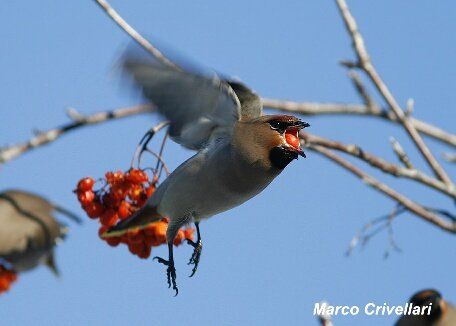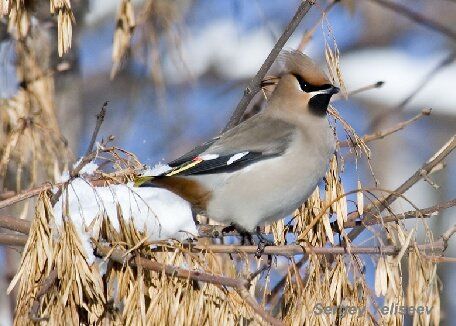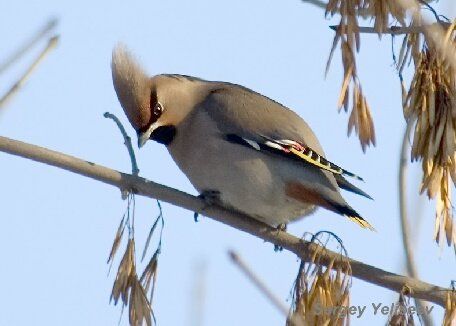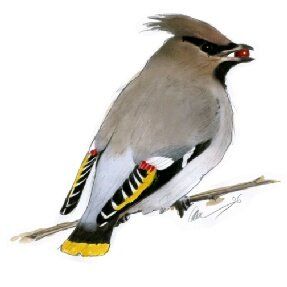The Bohemian waxwing (Bombycilla garrulus) is a starling-sized passerine bird that breeds in the northern forests of the Palearctic and North America. It has mainly buff-grey plumage, black face markings and a pointed crest. Its wings are patterned with white and bright yellow, and some feather tips have the red waxy appearance that give this species its English name. The three subspecies show only minor differences in appearance. Females are similar to males, although young birds are less well-marked and have few or no waxy wingtips. Although the Bohemian waxwing's range overlaps those of the cedar and Japanese waxwings, it is easily distinguished from them by size and plumage differences.
The breeding habitat is coniferous forests, usually near water. The pair build a lined cup-shaped nest in a tree or bush, often close to the trunk. The clutch of 3–7 eggs is incubated by the female alone for 13–14 days to hatching. The chicks are altricial and naked, and are fed by both parents, initially mostly with insects, but thereafter mainly fruit. They fledge about 14–16 days after leaving the egg. Many birds desert their nesting range in winter and migrate farther south. In some years, large numbers of Bohemian waxwings irrupt well beyond their normal winter range in search of the fruit that makes up most of their diet.
Waxwings can be very tame in winter, entering towns and gardens in search of food, rowan berries being a particular favourite. They can metabolise alcohol produced in fermenting fruit, but can still become intoxicated, sometimes fatally.
The Bohemian waxwing is a starling-sized bird 19–23 cm (7.5–9.1 in) in length with a 32–35.5 cm (12.6–14.0 in) wingspan, and an average weight of 55 g (1.9 oz). It is short-tailed, mainly brownish-grey, and has a conspicuous crest on its head. The male of the nominate subspecies has a black mask through the eye and a black throat. There is a white streak behind the bill and a white curve below the eye. The lower belly is a rich chestnut colour and there are cinnamon-coloured areas around the mask. The rump is grey and the tail ends in a bright yellow band with a broad black border above it. The wings are very distinctive; the flight feathers are black and the primaries have markings that produce a yellow stripe and white "fishhooks" on the closed wing. The adult's secondaries end in long red appendages with the sealing wax appearance that gives the bird its English name. The eyes are dark brown, the bill is mainly black, and the legs are dark grey or black. In flight, the waxwing's large flocks, long wings and short tail give some resemblance to the common starling, and its flight is similarly fast and direct. It clambers easily through bushes and trees but only shuffles on the ground.
The soft, dense feathers are kept in good condition by preening. The red waxy tips are the extended and flattened ends of feather shafts, pigmented with astaxanthin and enclosed in a transparent sheath. A study of the cedar waxwings showed that the red tips are few or absent until the third year of life for that related species.[20] All adult waxwings have a complete moult annually between August and January. Juveniles moult at the same time but retain their flight and some other wing feathers.
The female Bohemian waxwing is very similar to the male, but has a narrower yellow terminal band to the tail, a less defined lower edge to the black throat and slightly less distinctive wing markings. Juveniles are duller than adults, with whiter underparts, only a few red wing tips, no black on the throat and a smaller black face mask. Compared to the nominate subspecies, eastern B. g. centralasiae is paler, greyer and has little reddish-brown behind the bill. The American subspecies B. g. pallidiceps has more colouring on the cheeks and forehead than the nominate form and is otherwise generally duller in appearance.
Wikipedia
waxwing illustration by MiE Fielding







